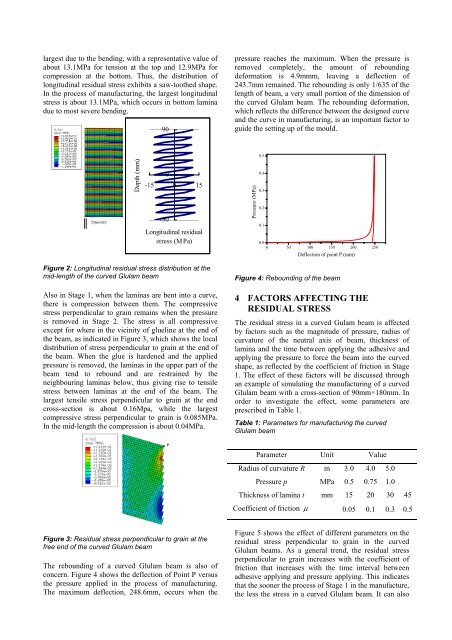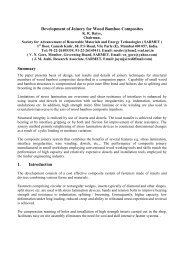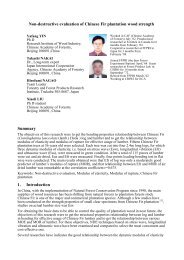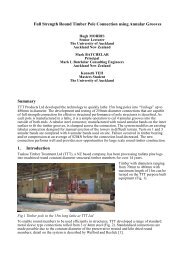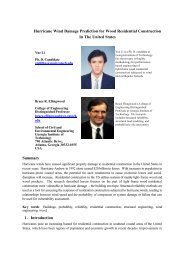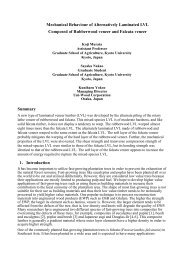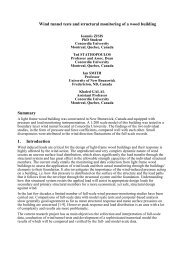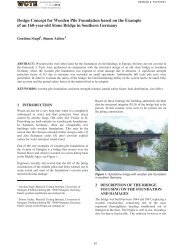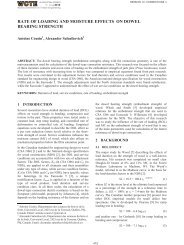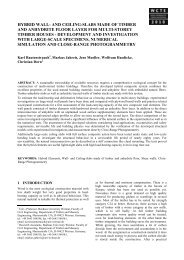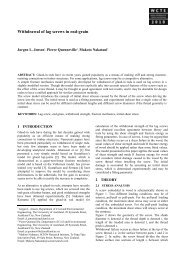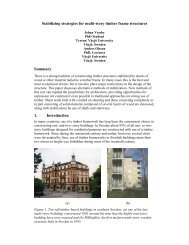simulation of residual stress in curved glulam beams - Engineered ...
simulation of residual stress in curved glulam beams - Engineered ...
simulation of residual stress in curved glulam beams - Engineered ...
You also want an ePaper? Increase the reach of your titles
YUMPU automatically turns print PDFs into web optimized ePapers that Google loves.
largest due to the bend<strong>in</strong>g, with a representative value <strong>of</strong><br />
about 13.1MPa for tension at the top and 12.9MPa for<br />
compression at the bottom. Thus, the distribution <strong>of</strong><br />
longitud<strong>in</strong>al <strong>residual</strong> <strong>stress</strong> exhibits a saw-toothed shape.<br />
In the process <strong>of</strong> manufactur<strong>in</strong>g, the largest longitud<strong>in</strong>al<br />
<strong>stress</strong> is about 13.1MPa, which occurs <strong>in</strong> bottom lam<strong>in</strong>a<br />
due to most severe bend<strong>in</strong>g.<br />
Depth (mm)<br />
90<br />
0<br />
-15 0 15<br />
-90<br />
Longitud<strong>in</strong>al <strong>residual</strong><br />
<strong>stress</strong> (MPa)<br />
Figure 2: Longitud<strong>in</strong>al <strong>residual</strong> <strong>stress</strong> distribution at the<br />
mid-length <strong>of</strong> the <strong>curved</strong> Glulam beam<br />
Also <strong>in</strong> Stage 1, when the lam<strong>in</strong>as are bent <strong>in</strong>to a curve,<br />
there is compression between them. The compressive<br />
<strong>stress</strong> perpendicular to gra<strong>in</strong> rema<strong>in</strong>s when the pressure<br />
is removed <strong>in</strong> Stage 2. The <strong>stress</strong> is all compressive<br />
except for where <strong>in</strong> the vic<strong>in</strong>ity <strong>of</strong> gluel<strong>in</strong>e at the end <strong>of</strong><br />
the beam, as <strong>in</strong>dicated <strong>in</strong> Figure 3, which shows the local<br />
distribution <strong>of</strong> <strong>stress</strong> perpendicular to gra<strong>in</strong> at the end <strong>of</strong><br />
the beam. When the glue is hardened and the applied<br />
pressure is removed, the lam<strong>in</strong>as <strong>in</strong> the upper part <strong>of</strong> the<br />
beam tend to rebound and are restra<strong>in</strong>ed by the<br />
neighbour<strong>in</strong>g lam<strong>in</strong>as below, thus giv<strong>in</strong>g rise to tensile<br />
<strong>stress</strong> between lam<strong>in</strong>as at the end <strong>of</strong> the beam. The<br />
largest tensile <strong>stress</strong> perpendicular to gra<strong>in</strong> at the end<br />
cross-section is about 0.16Mpa, while the largest<br />
compressive <strong>stress</strong> perpendicular to gra<strong>in</strong> is 0.085MPa.<br />
In the mid-length the compression is about 0.04MPa.<br />
Figure 3: Residual <strong>stress</strong> perpendicular to gra<strong>in</strong> at the<br />
free end <strong>of</strong> the <strong>curved</strong> Glulam beam<br />
The rebound<strong>in</strong>g <strong>of</strong> a <strong>curved</strong> Glulam beam is also <strong>of</strong><br />
concern. Figure 4 shows the deflection <strong>of</strong> Po<strong>in</strong>t P versus<br />
the pressure applied <strong>in</strong> the process <strong>of</strong> manufactur<strong>in</strong>g.<br />
The maximum deflection, 248.6mm, occurs when the<br />
pressure reaches the maximum. When the pressure is<br />
removed completely, the amount <strong>of</strong> rebound<strong>in</strong>g<br />
deformation is 4.9mmm, leav<strong>in</strong>g a deflection <strong>of</strong><br />
243.7mm rema<strong>in</strong>ed. The rebound<strong>in</strong>g is only 1/635 <strong>of</strong> the<br />
length <strong>of</strong> beam, a very small portion <strong>of</strong> the dimension <strong>of</strong><br />
the <strong>curved</strong> Glulam beam. The rebound<strong>in</strong>g deformation,<br />
which reflects the difference between the designed curve<br />
and the curve <strong>in</strong> manufactur<strong>in</strong>g, is an important factor to<br />
guide the sett<strong>in</strong>g up <strong>of</strong> the mould.<br />
Pressure (MPa)<br />
0.5<br />
0.4<br />
0.3<br />
0.2<br />
0.1<br />
0.0<br />
0 50 100 150 200 250<br />
Deflection <strong>of</strong> po<strong>in</strong>t P (mm)<br />
Figure 4: Rebound<strong>in</strong>g <strong>of</strong> the beam<br />
4 FACTORS AFFECTING THE<br />
RESIDUAL STRESS<br />
The <strong>residual</strong> <strong>stress</strong> <strong>in</strong> a <strong>curved</strong> Gulam beam is affected<br />
by factors such as the magnitude <strong>of</strong> pressure, radius <strong>of</strong><br />
curvature <strong>of</strong> the neutral axis <strong>of</strong> beam, thickness <strong>of</strong><br />
lam<strong>in</strong>a and the time between apply<strong>in</strong>g the adhesive and<br />
apply<strong>in</strong>g the pressure to force the beam <strong>in</strong>to the <strong>curved</strong><br />
shape, as reflected by the coefficient <strong>of</strong> friction <strong>in</strong> Stage<br />
1. The effect <strong>of</strong> these factors will be discussed through<br />
an example <strong>of</strong> simulat<strong>in</strong>g the manufactur<strong>in</strong>g <strong>of</strong> a <strong>curved</strong><br />
Glulam beam with a cross-section <strong>of</strong> 90mm×180mm. In<br />
order to <strong>in</strong>vestigate the effect, some parameters are<br />
prescribed <strong>in</strong> Table 1.<br />
Table 1: Parameters for manufactur<strong>in</strong>g the <strong>curved</strong><br />
Glulam beam<br />
Parameter Unit Value<br />
Radius <strong>of</strong> curvature R m 3.0 4.0 5.0<br />
Pressure p MPa 0.5 0.75 1.0<br />
Thickness <strong>of</strong> lam<strong>in</strong>a t mm 15 20 30 45<br />
Coefficient <strong>of</strong> friction µ 0.05 0.1 0.3 0.5<br />
Figure 5 shows the effect <strong>of</strong> different parameters on the<br />
<strong>residual</strong> <strong>stress</strong> perpendicular to gra<strong>in</strong> <strong>in</strong> the <strong>curved</strong><br />
Glulam <strong>beams</strong>. As a general trend, the <strong>residual</strong> <strong>stress</strong><br />
perpendicular to gra<strong>in</strong> <strong>in</strong>creases with the coefficient <strong>of</strong><br />
friction that <strong>in</strong>creases with the time <strong>in</strong>terval between<br />
adhesive apply<strong>in</strong>g and pressure apply<strong>in</strong>g. This <strong>in</strong>dicates<br />
that the sooner the process <strong>of</strong> Stage 1 <strong>in</strong> the manufacture,<br />
the less the <strong>stress</strong> <strong>in</strong> a <strong>curved</strong> Glulam beam. It can also


